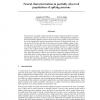Free Online Productivity Tools
i2Speak
i2Symbol
i2OCR
iTex2Img
iWeb2Print
iWeb2Shot
i2Type
iPdf2Split
iPdf2Merge
i2Bopomofo
i2Arabic
i2Style
i2Image
i2PDF
iLatex2Rtf
Sci2ools
NIPS
2007
2007
Neural characterization in partially observed populations of spiking neurons
Point process encoding models provide powerful statistical methods for understanding the responses of neurons to sensory stimuli. Although these models have been successfully applied to neurons in the early sensory pathway, they have fared less well capturing the response properties of neurons in deeper brain areas, owing in part to the fact that they do not take into account multiple stages of processing. Here we introduce a new twist on the point-process modeling approach: we include unobserved as well as observed spiking neurons in a joint encoding model. The resulting model exhibits richer dynamics and more highly nonlinear response properties, making it more powerful and more flexible for fitting neural data. More importantly, it allows us to estimate connectivity patterns among neurons (both observed and unobserved), and may provide insight into how networks process sensory input. We formulate the estimation procedure using variational EM and the wake-sleep algorithm, and illu...
| Added | 30 Oct 2010 |
| Updated | 30 Oct 2010 |
| Type | Conference |
| Year | 2007 |
| Where | NIPS |
| Authors | Jonathan Pillow, Peter E. Latham |
Comments (0)

